Unmanned aerial vehicles, as simulated targets of aircraft type, can provide air targets for air defense weapon system fire control radar calibration, shooting and other tasks, and are indispensable equipment in the development and identification of weapon systems. As one of the core components of a drone, the flight control system controls the drone's attitude to complete the flying missions in various modalities of the drone. Existing testing methods for a UAV flight control system include discrete component testing and integrated testing of the complete machine after the components are installed. Both methods belong to the routine static test. The organization and implementation are complicated, the test efficiency is low, the mission preparation period is long, and the dynamic performance of the actual flight process of the drone cannot be verified. It is difficult to locate the faults that occurred during the test. The environmental interference factors (mainly wind interference) and the flight situation of the UAV after the sensor fails cannot be simulated, so that the flight control strategy cannot be modified in a targeted manner. In summary, the task of developing a semi-physical simulation platform for UAV flight control systems is particularly urgent.
1 Overall platform function and design scheme 1.1 Overall platform functionThe platform uses an existing UAV flight control system as the test object, and mainly completes the following functions:
(1) Combine with the UAV flight control computer, electric steering gear, throttle motor and other physical objects to complete the simulation test of the flight control system;
(2) It has flight performance simulation under the conditions of wind interference and torque interference, and displays the flight path, rudder deviation angle, rudder deviation rate and other changes of the UAV in real time in a two-dimensional curve mode;
(3) It is possible to set the faults of some sensors of the UAV flight control system and perform flight modal simulation in the case of faults.
1.2 Overall design plan of the platformThe semi-physical simulation platform is composed of hardware equipment and application software. The hardware equipment includes the newly built flight system simulation subsystem, sensors and airborne measurement and control simulation subsystem, remote control / telemetry simulation subsystem, command display subsystem, UAV shape display subsystem, as well as the existing flight control computer and flight control Computer interface box, electric steering gear, throttle motor and other physical objects. The application software includes the newly built application programs of each sub-system. The schematic block diagram of the semi-physical simulation platform is shown in Figure 1.
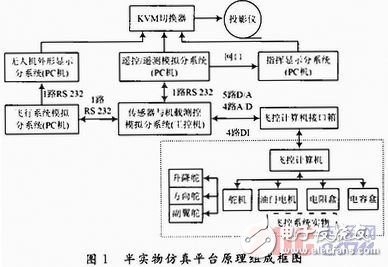
The working principle of the semi-physical simulation platform is summarized as follows: the sensor and the airborne measurement and control simulation subsystem exchange information such as the rudder declination, angular rate, throttle opening, remote control commands, external interference and other information of the UAV through the interface box and the flight control computer Transmit the sampled and converted flight control computer execution results to the flight system simulation subsystem, and transmit telemetry information to the remote control / telemetry simulation subsystem (including simulation data of sensors and airborne measurement and control simulation equipment, fault status, remote control command return, etc.). After the flight control computer receives the information and performs the calculation process, it controls the electric steering gear and throttle motor to perform the corresponding actions, and returns the execution results to the sensor and the onboard measurement and control simulation subsystem. The flight system simulation subsystem sends the resolved aircraft state parameters to the UAV shape display subsystem, and displays the UAV's attitude, throttle opening, altitude change and other information in the form of three-dimensional animation after the solution. The command display subsystem displays the received UAV position, altitude, and speed information on the digital map, and issues a command password in due course, and the operator interferes with the flight of the UAV. The three-dimensional appearance, measurement and control data, and command and display interface of the UAV are displayed on the projection screen in a time-sharing manner through the KVM switch.
2 Platform hardware design scheme 2.1 Platform hardware selection principles(1) Selection principle of application software operating platform
Because the platform is a fixed test equipment, the hardware used in the application software running platform of each subsystem should use rack-type industrial computers or desktop computers as far as possible. The number and type of motherboard slots should be relatively abundant to facilitate existing hardware boards Installation and subsequent function expansion of the platform.
(2) The selection principle of the data acquisition card: one is to ensure the number of channels; the second is to ensure the sampling frequency; the third is to ensure the data resolution.
2.2 Platform hardware selection scheme(1) Sensor and airborne measurement and control analog subsystem
The subsystem includes a large number of signal acquisition, exchange and processing tasks, and the hardware adopts an industrial computer architecture. Configure data acquisition card, multi-serial card and self-developed signal conditioning card to complete data acquisition and information exchange.
The specific hardware model and basic parameters are:
The industrial computer adopts Siemens 547B: 64-bit CPU processor, 4 PCI slots, and 1 PCI-Ex16 graphics expansion interface.
The multi-serial card selects MOXA CP 118U: 4-channel RS 232/422/485 PCI serial port, the serial port communication rate is 921.6 Kb / s; onboard 15 kVESD surge protection.
The D / A card uses NI PCI-6733: 8-channel D / A, data update rate 1 MS / s (16b), and 8-channel digital I / O.
The A / D card selects NI PCIe-6259: 4-channel D / A, data update rate is 1 Ms / s (16 b), 32-channel A / D channels; A / D sampling rate is 2.8 MS / s ( 16 b), 48 digital I / O.
DIO card selects NI PCIe-6503: 24-channel digital I / O.
(2) Flight system simulation subsystem, remote control / telemetry simulation subsystem
These two subsystems are mainly used for the transmission and calculation of unmanned aerial vehicles and measurement and control data. The hardware composition is relatively simple. You can select an ordinary commercial desktop computer with multiple types of motherboard slots and configure the MOXA CP118U multi-serial card.
(3) Command display subsystem, UAV shape display subsystem
These two sub-systems are mainly used for commanding and displaying application software. You can select ordinary commercial desktop computers with multiple types of motherboard slots.
2.3 Design of self-made signal conditioning cardWhen the sensor and airborne measurement and control simulation subsystem and remote control / telemetry simulation subsystem, flight system simulation subsystem, flight control computer interface box and other parts exchange data, when the signal conversion is completed through D / A, A / D, DIO board It will be affected by the complex electromagnetic environment in the chassis, resulting in strong noise in the output signal, which needs to be filtered. In addition, because the input and output voltages of the flight control computer interface box are +27 V, and the working voltage of D / A, A / D, and DIO boards is +5 V, it is necessary to design a signal conditioning card to complete signal filtering and working voltage. Conversion. The schematic diagram of the connection between the signal conditioning card and external components is shown in Figure 2.

Platform application software includes five application software: flight system simulation subsystem, UAV shape display subsystem, sensors and airborne measurement and control simulation subsystem, remote control / telemetry simulation subsystem, command display subsystem.
3.1 Flight system simulation subsystemMainly by solving the UAV dynamic model, get the UAV's attitude, engine and other information to achieve UAV flight simulation. The simulation process also considers the binding of wind interference and torque interference.
(1) Selection of application software development environment
Due to the need to solve the UAV dynamic model, considering that VC ++ 6.0 has a large number of function calculation libraries, and its data calculation ability is relatively outstanding, so VC ++ 6.0 is selected as the application software development environment.
(2) Establishment of UAV dynamic model
The establishment of the UAV dynamic model is the basis of flight system simulation. According to the references, the UAV dynamic model is established.
(3) Loading of wind disturbance and torque disturbance
Wind disturbance simulation is mainly to decompose and project the wind speed and wind direction on each body axis, and then combine the three-way velocity equation in the aerodynamic equation system to solve the three-way velocity, and substitute it into the dynamic model to solve the problem. Aircraft attitude parameters. The loading method of torque disturbance adopts the method of directly setting the corresponding parameters in the dynamic model. Set the content package interference torque, forward and reverse pulse interference, start time, end time, and the magnitude of constant torque.
(4) Implementation of application software
After the application software is completed, in order to prevent erroneous modification during the programming of other subsystem software, the UAV model is provided to the user by using the dynamic link library (UAVSimu.DLL), and the applied torque is set through the interference setting interface, as shown in the figure 3, shown in Figure 4.
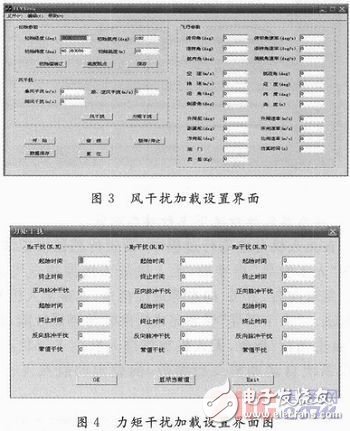
It can simulate the characteristics of sensors such as GPS receivers, magnetic heading, and atmospheric data computers, and output them to various related sub-systems in the form of digital or analog signals for actual platform simulation. The types of faults that can be set include:
GPS receiver failure, heading jump, big data computer altitude jump.
(1) Selection of application software development environment
Because the application software requires a lot of software interface development during the design process, the biggest advantage of Borland's C ++ Builder integrated development environment is its direct drag-in method in the software interface development process, which greatly facilitates engineering development. Therefore, C ++ Builder is selected for application software development.
(2) Software overall design and construction
Create a "ProjectSensorSim" project file, including the project file shown in Figure 5, after running the project file, generate a subsystem software interface, as shown in Figure 6.
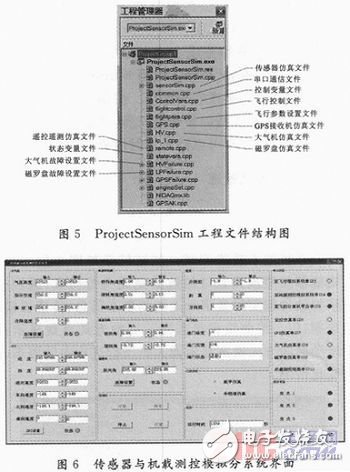
The subsystem is used to simulate the basic functions of the ground measurement and control station, and is used to complete the transmission of remote control commands and the reception of telemetry data. The software adopts modular design, including two-dimensional curve drawing, route binding, saving and deleting, track drawing, serial port processing, telemetry data reception, telemetry information processing, remote command processing and other modules.
3.4 Subsystem of UAV shape displayThe appearance display subsystem adopts VC ++ 2010 software and is developed based on OpenGL. Software modules include: communication interface module, three-dimensional demonstration module, instrument display module and so on.
3.5 Two key issues in the software development process(1) Technology to reduce communication time delay between systems
Due to the distributed and modular structure, the serial communication between the sub-systems will inevitably cause the problem of communication delay. During the software design process, the following measures were taken to solve:
â‘ Reduce the simulation step size of flight system simulation software, increase the continuity of flight parameters;
â‘¡Improve the serial port baud rate of attitude information transmission between the three subsystems of flight system simulation, sensor and airborne measurement and control simulation and flight control computer simulation;
â‘¢ Optimize the frame structure of serial data communication between the sensor and the airborne measurement and control analog subsystem and other subsystems; ensure that the attitude information reaches the flight control computer in the shortest time.
(2) Real-time processing technology of industrial control equipment data
Since the sensor and airborne measurement and control simulation subsystems adopt the industrial control computer architecture, data communication with multiple subsystems such as flight system simulation is required at the same time, and all tasks are required to be completed in milliseconds. In the software design, it uses MulTImedia TImer (multimedia timer) in combination with multithreading in the Windows environment. The application multimedia timer is an accurate timer supported by the computer from hardware. Its timing error can generally reach ten microseconds, which can fully meet the real-time requirements.
4 Platform functional test verification 4. 1 Flight control system simulation test functional verificationConnect the components of the platform as shown in Figure 1, run the application software, and test the basic functions of the entire system. The test results are shown in Figure 7. The drone can complete the flight simulation according to the pre-booked route; the remote control / telemetry simulation software can display the attitude information and sensor simulation information of the drone in real time, and display it intuitively in the form of two-dimensional curves and status indicators; Realistic display of the attitude and altitude changes of the UAV during flight.

(1) Simulation in wind interference mode
In the flight system simulation subsystem, through the "wind interference" function button, set the wind interference to 90 ° north, 80 m / s and 180 °, 80 m / s to observe the change of flight path of the UAV flight simulation , As shown in Figure 8. It can be seen that after the drone is disturbed by the wind, the flight path has changed significantly for a short time, and then the flight control system can correct the deviation of the route in time, so that the drone will fly according to the predetermined route.
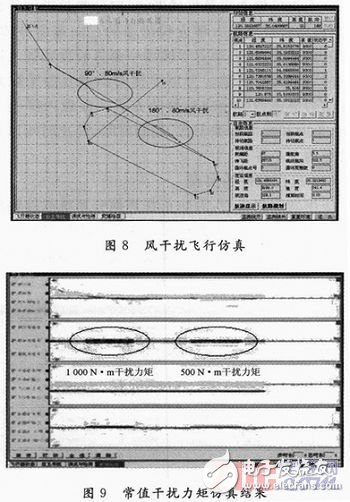
(2) Simulation under the action of interference torque
In the simulation subsystem of the flight system, set the external disturbances to be 1000 N · m and 500 N · m constant disturbance torque, and observe the simulation situation of the UAV under this disturbance situation, as shown in Figure 9. It can be seen from the figure that the rudder declination angle and the rudder declination rate of the UAV under different moments are affected. When the interference force / torque is applied, the drone attitude changes significantly, and the flight control system continuously adjusts the rudder declination angle and the rudder declination rate to eliminate the effect of external interference and ensure that the drone can follow the predetermined attitude Normal flight.
4.3 Flight modal test under sensor failureDuring the autonomous flight of the drone, the sensor is set to simulate the fault, and after sending the "manual guidance" command, the drone enters the remote control command flight mode. Send remote control commands such as right, direct, and left to observe the flight path of the drone. After the "manual guidance" mode is completed, the sensor fault is removed, and then the "autonomous flight" command is sent, and the drone re-enters the autonomous flight state. The flight control system automatically adjusts the flight parameters to the set waypoint, as shown in Figure 10. Show.
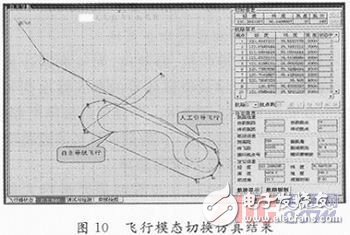
This article introduces the basic functions, overall technical solutions, hardware selection solutions and software design solutions of the UAV flight control system semi-physical simulation platform. Finally, the basic functions of the platform were tested and verified. The platform can be used not only for simulation testing of flight control systems, but also for the study of UAV flight laws, flight performance evaluation, and simulation training of control personnel.
Divide an optical jumper into two to become two optical pigtails.
The optical jumper refers to the optical connection line with the optical fiber movable connector installed at both ends of the optical fiber or optical cable. It is usually used for fiber patching or switching in distribution equipment or between optical equipment, and the length is usually no more than 10 meters.
It is a popular and common saying in the industry that when the connecting wire is an optical cable (indoor optical cable), it is called an optical fiber jumper, and when the connecting wire is an optical fiber, it is called an optical fiber jumper.
In mobile communications, coaxial cable jumpers have special product standards, while optical jumpers are different. Optical jumpers do not have special product standards. Because the attenuation of optical fibers is very small, and the length of optical jumpers is not long, the optical fiber attenuation is negligible. Therefore, the optical fiber movable connector standard is also used as the optical patch cord standard in practice. Some content of the optical fiber movable connector is different from the optical patch cord. However, in the long run, the industry has already considered the optical fiber movable connector standard That is, it is the standard for optical patch cords.
Lc Pigtail,Fc Pigtail,Sc Pigtail,Communication Devices,E2000 Pigtail
Shenzhen GL-COM Technology CO.,LTD. , https://www.szglcom.com
